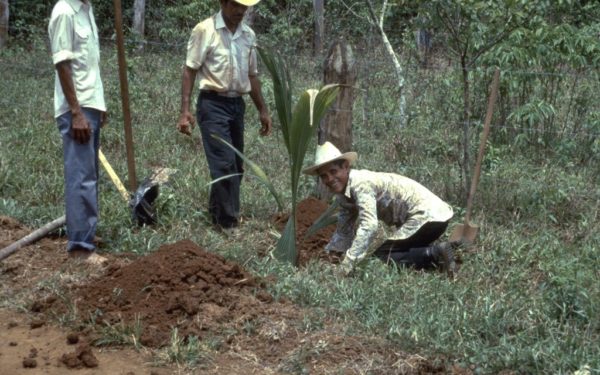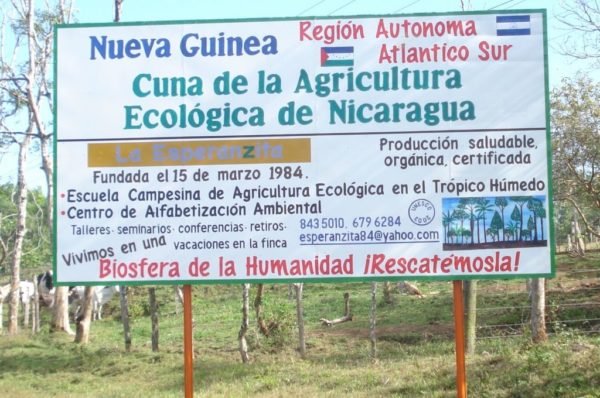Organic Agriculture Celebrates 40 Years in Nicaragua

Gerd Schnepel and his wife Elba Rivera founded the farm called “La Esperanzita” in 1984. It was the first site in Nicaragua to practice organic agriculture.
HAVANA TIMES – It all began in January 1982 with the arrival of an “internationalist” from what was then West Germany. He wanted to see firsthand the reality of the revolution that had ended the rule of Anastasio Somoza, a man sadly notorious in Germany as a dictator. The German internationalist wanted to contribute his “grain of sand” to the construction of the new Nicaragua by working in organic agriculture. But ecologically friendly agriculture didn’t exist in the country.
On March 15, 1984, Gerd Schnepel and his wife Elba Rivera founded the farm they baptized “La Esperanzita” in the southeastern region of Nicaragua known as Nueva Guinea. Elba was the daughter of a rural family from that area. “La Esperanzita” was the first place to pioneer organic agriculture in Nicaragua.
At that time, Jaime Wheelock, then Minister of Agriculture, came to Nueva Guinea and spoke from the landing strip to hundreds of gathered farmers. Among other things, he said: “If you continue with your current style of agriculture, you’ll transform this region into a desert!”
A very substantial joint study of the European Union and the Nicaraguan Agricultural Reform Ministry had already been conducted in 1981, analyzing the soil types, water, vegetation, and climate of the southeastern tropical wetlands. It had reached the conclusion that a jungle region such as this had – above all – a “forestry vocation.” The study also outlined what would be inappropriate, inadequate, and imprudent to practice in a wet tropical climate. At that time, all the erroneous practices they mentioned were the standard techniques!
The numbers of land colonists had been growing in Nueva Guinea since 1965. Colonies likeRío Plata, El Campamento, La Angostura, Punta Gorda, La Fonseca, El Paraíso de Aguas Zarcas, Atlanta, La Unión, and La Providencia, among others, were already thriving. Since all these farmers had come from the Pacific, central and northern zones of Nicaragua, they continued with the practices they’d always used: post-crop burning, deforestation, the planting of rice, corn, beans, yucca and purple Malanga. Later came cattle-raising, the activity that places the heaviest burden on the nature of the tropical wetlands. There were no elder farmers there to teach these rural colonists how to work in the tropical wetland ecology. There were no healthy agricultural traditions – only erroneous ones.

In 1967, Chele Gerardo’s father-in-law, Orlando Rivera was harvesting some 40 hundredweight bags, or 4,000 lbs. per acre, from the former jungle areas now “free” for cultivation by the “free farmers,” without the aid of agrochemicals. When asked in 1988 how much he was producing then, his slightly subdued reply was: “eight, or five hundred lbs., or not even that.”
Of course, the indigenous peoples of the zone had been practicing ecological agriculture for centuries, though their traditional practice of “itinerant farming” and mixing crops, like corn, beans, squashes. But now, a new era had arrived. To be sure the farmers knew there’d been a Revolution, the government brought in heavy machinery from Eastern Europe, a torture for the delicate soils of the tropical wetlands, and above all – agrochemicals!
Thus began the long-term poisoning of producers and consumers and the compacting of the soil with the consequent alteration of the hydric balance. In front of nearly every small farmer’s hut stood an empty barrel of East German pesticide, now superficially washed and serving as the family’s water barrel. Economically, “short-term interests” were the order of the day. How to make money fast! Contract agriculture for the soil, beef cattle on enormous pastures bare of trees, and the wild dream of becoming the “grain basket” not only of Nicaragua, but for all of Central America. Then-president Arnoldo Aleman [1997 – 2002], who had no idea, except perhaps about coffee plantations in the northern mountains, continued rambling about this for many years.
“La Esperanzita’s” way of farming
The farm they called “La Esperanzita” had to offer some response, had to show that things could be done another way. Little by little, sustainability became a concept. The guiding principles were: no heavy machinery, nearly no plowing, absolutely no use of chemical fertilizers, no pesticides, no monoculture, no genetically modified seeds, no improved seeds (favored by President Enrique Bolaños’ who succeeded Aleman in office). Instead, the farmers used proven local varieties of seeds that they preserved every year for use on the following cycle.
“Agriculture must work with Mother Nature, not fight her,” was the golden rule. Hence, natural fertilizer; composting from manure; earthworm droppings; crop rotation; mixed crops of every kind; green fertilizer from velvet beans, kudzu and other plants; wood vinegar, onion, chili and garlic extracts to combat any plagues that appeared; pelibuey sheep instead of cattle. ‘La Esperanzita” tried all these things and introduced them onto their lands.
Even organic veterinary medicine was taught and practiced on the farm, under the direction of Carlos Saenz Scott, a passionate ecological veterinarian.
But the best part was, and remains, the respect given to the land’s natural aptitude for forestry, by emphasizing diversified and ecological agroforestry. This signifies agricultural production based on trees, bushes and climbing plants, imitating the jungle, which has been producing enormous amounts of biomass for thousands of years, without “artificial complements” and without Bayer, Monsanto and company.
The bravest small producers used their ¾ or 1 ½ hectare agroforestry plots to plant annatto, avocado, basil, arazá, squash, bananas, cocoa, coffee, star apple, cinnamon, star fruit, chestnut, chili, turmeric, hibiscus flowers, breadfruit, pigeon peas, passion fruit, soursop, guava, ginger, lemon, Chinese mangosteen, cashew, orange, coconut palm, papaya, brava pepper, sweet peppers, pineapples, plantains, grapefruit, cat’s claw, vanilla,, jackfruit, lemon grass and other tree or shrub-based crops, all intelligently mixed.
The challenges of agroforestry production are shade management and sophisticated pruning. However, the advantages include few diseases, few pests in mixed cultivation, and few weeds, because everything is already covered with plants and often shaded.

The most important of the species mentioned enjoy an ever-growing demand for organic produce at local independent farmers’ markets in both the countryside and the cities. They also command high prices in the export market, once certified as organic. Perhaps each producer isn’t harvesting large quantities, so they form associations, cooperatives, or other types of collectives. Also, they harvest all year round.
Tree-based crops are sources of health, income, and represent an enormously important contribution against the climate crisis, both locally and on a world scale. The “La Esperanzita” farm continues teaching this through practice and experimentation, and as a rural school of organic agriculture in the tropic wetlands. Its workshops have motivated hundreds, perhaps thousands, of rural families to spread the new techniques. It’s also trying to win over women and young people in particular, so that together they can find solutions and build an agricultural practice in accordance with the reminder from the famous Nicaraguan ecologist and thinker Dr. Jaime Incer Barquero, who pointed out that those of us now in Nicaragua aren’t the last ones. “After us, millions of Nicaraguans will be born who want and need to live with, and from, the very same land, soil, water, air, plants, and animals. Just as we do.”
The ideas and suggestions from “La Esperanzita” have now been extended to Cerro Silva, Bluefields, Rama Key, and other communities of the Rama-Kriol indigenous peoples. They’re also being tried in Punta Gorda, El Rama, Santa Isabel del Pajarito, and other places in Rio San Juan department, plus the Caribbean coast communities of Kukra Hill, Pearl Lagoon and the Southern Triangle.






Readers, please copy & paste this to every eco-publication you know of in your countries – and other countries, too.